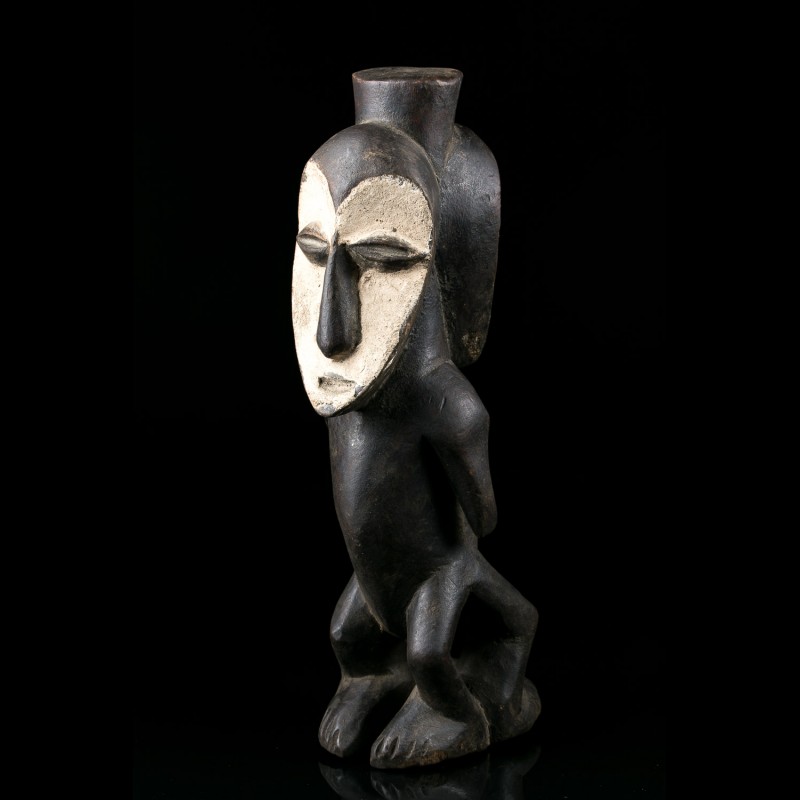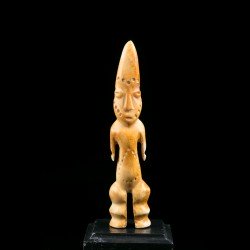









The Lega of eastern Congo live mostly in small isolated communities due to their environment - dense rainforest in the west and rocky and less fertile land in the east. Traditionally, the Lega were mostly hunters and farmers.The Bwami society to which almost all Lega men and many women belong, is a complex hierarchical social organisation with several levels, through which members progress slowly, each advancement attained through the acquisition of knowledge through oral and visual teachings, and the distribution of gifts of food, tools, shell money, clothing, etc., to fellow members of the appropriate grade. The oral teachings are learned in the form of sung aphorisms, poetic, highly symbolic, proverb-like texts.Anthropomorphic carvings were made for members of the two highest Bwami grades, Kindi and Yananio, the former having priority to those made in ivory. The presentation and viewing of the figures marked the summit of initiation rites. In one rite the figure would be oiled and perfumed before being displayed to the accompaniment of secret songs. The figures are aphorisms but their meanings can rarely be identified once removed from their ritual context. They sometimes represent people (e. g. Mungema is the man who shouts at feasts) but others illustrate songs, proverbs and legends. They were jealously guarded by their owners, who kept them in basket and turned and rubbed them.Masks and maskettes in ivory, bone or wood were rarely worn on the face as widely seen elsewhere in Africa. Instead they were attached to a small fence made of sticks and vines, sometimes carried before the face or on the cheeks, or occasionally placed on top of the head.When a member died his personal ritual figures and other items were carefully preserved and passed down through the generations, accumulating the power of the initiates through whose hands they had passed, so a Bwami member might have several figures in his possession. This would be an indication of higher status and a relative seniority within the grade.
Data sheet
You might also like

The Lega of eastern Congo live mostly in small isolated communities due to their environment - dense rainforest in the west and rocky and less fertile land in the east. Traditionally, the Lega were mostly hunters and farmers.The Bwami society to which almost all Lega men and many women belong, is a complex hierarchical social organisation with several levels, through which members progress slowly, each advancement attained through the acquisition of knowledge through oral and visual teachings, and the distribution of gifts of food, tools, shell money, clothing, etc., to fellow members of the appropriate grade. The oral teachings are learned in the form of sung aphorisms, poetic, highly symbolic, proverb-like texts.Anthropomorphic carvings were made for members of the two highest Bwami grades, Kindi and Yananio, the former having priority to those made in ivory. The presentation and viewing of the figures marked the summit of initiation rites. In one rite the figure would be oiled and perfumed before being displayed to the accompaniment of secret songs. The figures are aphorisms but their meanings can rarely be identified once removed from their ritual context. They sometimes represent people (e. g. Mungema is the man who shouts at feasts) but others illustrate songs, proverbs and legends. They were jealously guarded by their owners, who kept them in basket and turned and rubbed them.Masks and maskettes in ivory, bone or wood were rarely worn on the face as widely seen elsewhere in Africa. Instead they were attached to a small fence made of sticks and vines, sometimes carried before the face or on the cheeks, or occasionally placed on top of the head.When a member died his personal ritual figures and other items were carefully preserved and passed down through the generations, accumulating the power of the initiates through whose hands they had passed, so a Bwami member might have several figures in his possession. This would be an indication of higher status and a relative seniority within the grade.
